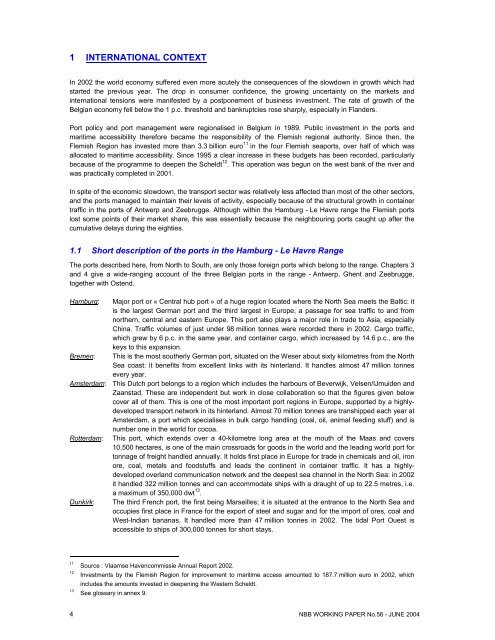Economic importance of the Flemish maritime ports: Report 2002
Economic importance of the Flemish maritime ports: Report 2002
Economic importance of the Flemish maritime ports: Report 2002
Create successful ePaper yourself
Turn your PDF publications into a flip-book with our unique Google optimized e-Paper software.
1 INTERNATIONAL CONTEXTIn <strong>2002</strong> <strong>the</strong> world economy suffered even more acutely <strong>the</strong> consequences <strong>of</strong> <strong>the</strong> slowdown in growth which hadstarted <strong>the</strong> previous year. The drop in consumer confidence, <strong>the</strong> growing uncertainty on <strong>the</strong> markets andinternational tensions were manifested by a postponement <strong>of</strong> business investment. The rate <strong>of</strong> growth <strong>of</strong> <strong>the</strong>Belgian economy fell below <strong>the</strong> 1 p.c. threshold and bankruptcies rose sharply, especially in Flanders.Port policy and port management were regionalised in Belgium in 1989. Public investment in <strong>the</strong> <strong>ports</strong> and<strong>maritime</strong> accessibility <strong>the</strong>refore became <strong>the</strong> responsibility <strong>of</strong> <strong>the</strong> <strong>Flemish</strong> regional authority. Since <strong>the</strong>n, <strong>the</strong><strong>Flemish</strong> Region has invested more than 3.3 billion euro 11 in <strong>the</strong> four <strong>Flemish</strong> sea<strong>ports</strong>, over half <strong>of</strong> which wasallocated to <strong>maritime</strong> accessibility. Since 1995 a clear increase in <strong>the</strong>se budgets has been recorded, particularlybecause <strong>of</strong> <strong>the</strong> programme to deepen <strong>the</strong> Scheldt 12 . This operation was begun on <strong>the</strong> west bank <strong>of</strong> <strong>the</strong> river andwas practically completed in 2001.In spite <strong>of</strong> <strong>the</strong> economic slowdown, <strong>the</strong> transport sector was relatively less affected than most <strong>of</strong> <strong>the</strong> o<strong>the</strong>r sectors,and <strong>the</strong> <strong>ports</strong> managed to maintain <strong>the</strong>ir levels <strong>of</strong> activity, especially because <strong>of</strong> <strong>the</strong> structural growth in containertraffic in <strong>the</strong> <strong>ports</strong> <strong>of</strong> Antwerp and Zeebrugge. Although within <strong>the</strong> Hamburg - Le Havre range <strong>the</strong> <strong>Flemish</strong> <strong>ports</strong>lost some points <strong>of</strong> <strong>the</strong>ir market share, this was essentially because <strong>the</strong> neighbouring <strong>ports</strong> caught up after <strong>the</strong>cumulative delays during <strong>the</strong> eighties.1.1 Short description <strong>of</strong> <strong>the</strong> <strong>ports</strong> in <strong>the</strong> Hamburg - Le Havre RangeThe <strong>ports</strong> described here, from North to South, are only those foreign <strong>ports</strong> which belong to <strong>the</strong> range. Chapters 3and 4 give a wide-ranging account <strong>of</strong> <strong>the</strong> three Belgian <strong>ports</strong> in <strong>the</strong> range - Antwerp, Ghent and Zeebrugge,toge<strong>the</strong>r with Ostend.Hamburg: Major port or « Central hub port » <strong>of</strong> a huge region located where <strong>the</strong> North Sea meets <strong>the</strong> Baltic: itis <strong>the</strong> largest German port and <strong>the</strong> third largest in Europe, a passage for sea traffic to and fromnor<strong>the</strong>rn, central and eastern Europe. This port also plays a major role in trade to Asia, especiallyChina. Traffic volumes <strong>of</strong> just under 98 million tonnes were recorded <strong>the</strong>re in <strong>2002</strong>. Cargo traffic,which grew by 6 p.c. in <strong>the</strong> same year, and container cargo, which increased by 14.6 p.c., are <strong>the</strong>keys to this expansion.Bremen: This is <strong>the</strong> most sou<strong>the</strong>rly German port, situated on <strong>the</strong> Weser about sixty kilometres from <strong>the</strong> NorthSea coast: it benefits from excellent links with its hinterland. It handles almost 47 million tonnesevery year.Amsterdam: This Dutch port belongs to a region which includes <strong>the</strong> harbours <strong>of</strong> Beverwijk, Velsen/IJmuiden andZaanstad. These are independent but work in close collaboration so that <strong>the</strong> figures given belowcover all <strong>of</strong> <strong>the</strong>m. This is one <strong>of</strong> <strong>the</strong> most important port regions in Europe, supported by a highlydevelopedtransport network in its hinterland. Almost 70 million tonnes are transhipped each year atAmsterdam, a port which specialises in bulk cargo handling (coal, oil, animal feeding stuff) and isnumber one in <strong>the</strong> world for cocoa.Rotterdam: This port, which extends over a 40-kilometre long area at <strong>the</strong> mouth <strong>of</strong> <strong>the</strong> Maas and covers10,500 hectares, is one <strong>of</strong> <strong>the</strong> main crossroads for goods in <strong>the</strong> world and <strong>the</strong> leading world port fortonnage <strong>of</strong> freight handled annually. It holds first place in Europe for trade in chemicals and oil, ironore, coal, metals and foodstuffs and leads <strong>the</strong> continent in container traffic. It has a highlydevelopedoverland communication network and <strong>the</strong> deepest sea channel in <strong>the</strong> North Sea: in <strong>2002</strong>it handled 322 million tonnes and can accommodate ships with a draught <strong>of</strong> up to 22.5 metres, i.e.a maximum <strong>of</strong> 350,000 dwt 13 .Dunkirk: The third French port, <strong>the</strong> first being Marseilles; it is situated at <strong>the</strong> entrance to <strong>the</strong> North Sea andoccupies first place in France for <strong>the</strong> export <strong>of</strong> steel and sugar and for <strong>the</strong> import <strong>of</strong> ores, coal andWest-Indian bananas. It handled more than 47 million tonnes in <strong>2002</strong>. The tidal Port Ouest isaccessible to ships <strong>of</strong> 300,000 tonnes for short stays.111213Source : Vlaamse Havencommissie Annual <strong>Report</strong> <strong>2002</strong>.Investments by <strong>the</strong> <strong>Flemish</strong> Region for improvement to <strong>maritime</strong> access amounted to 187.7 million euro in <strong>2002</strong>, whichincludes <strong>the</strong> amounts invested in deepening <strong>the</strong> Western Scheldt.See glossary in annex 9.4 NBB WORKING PAPER No.56 - JUNE 2004
















